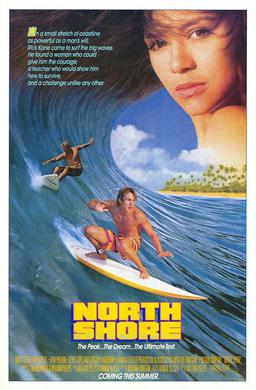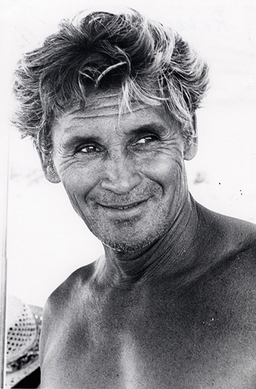
Bruce Alan Brown was an American documentary film director, known as an early pioneer of the surf film. He was the father of filmmaker Dana Brown.

Skip Frye is an American surfer, surfboard designer and shaper, and environmental activist.

North Shore is a 1987 American action drama surf film directed by William Phelps. The film is about Rick Kane, a young surfer from a wave tank in Arizona, who heads to surf the season on the North Shore of Oʻahu to see if he has the skills to cut it as a pro surfer. As he progresses on his journey, he learns the qualities he possesses are not going to pull him through alone.
Clark Foam was a Californian company that manufactured surfboard blanks — foam slabs, reinforced with one or more wooden strips or "stringers" — cast in the rough shape of a surfboard and used by surfboard shapers to create finished surfboards. Founded in 1961 by Gordon "Grubby" Clark, Clark Foam established a near-monopoly on the American market, and a strong presence in the international market, which it held until the company's unexpected closure in 2005.
Robert August is an American surfer and surfboard shaper. He is best known as one of the subjects of Bruce Brown's 1966 surf documentary The Endless Summer, along with his friend Mike Hynson.

The riding of waves has likely existed since humans began swimming in the ocean. In this sense, bodysurfing is the oldest type of wave-catching. Undoubtedly ancient sailors learned how to ride wave energy on many styles of early boats. Archaeological evidence even suggests that ancient cultures of Peru surfed on reed watercraft for fishing and recreation up to five thousand years ago. However, standing up on what is now called a surfboard is a relatively recent innovation developed by the Polynesians. The influences for modern surfing can be directly traced to the surfers of pre-contact Hawaii.
Kanvas By Katin, founded in 1954 and located in Surfside, California, is one of the oldest surf shops in California.

Albert "Rabbit" Kekai was an American surfer and one of the original innovators of modern surfing. He was a dominant master of the sport in the 1930s, 1940s, and 1950s, and was also a winner of the Peruvian and Makaha International titles.
Bruce Jones was a founding pioneer in the surfboard shaping industry.

Hobart "Hobie" Alter was an American surf and sailing entrepreneur and pioneer, creator of the Hobie Cat catamarans, and founder of the Hobie company.

Dane Reynolds is an American professional surfer from Ventura, California. He is known for his "go for broke" style of surfing that includes many experimental and aerial maneuvers.
The U.S. Open of Surfing is a week-long surfing competition held annually during the summer in Huntington Beach, California. Generally held on the south side of the Huntington Beach Pier, the U.S. Open is part of the qualification process for the World Surf League and is a WSL QS 10,000 event. It is the largest surfing competition in the world. It has been owned by IMG since 2000.
David Earl Weber, known as Dewey Weber, was an American surfer, a popular surfing film subject, and a successful surfboard manufacturing businessman. Throughout the 1950s and 1960s, he distinguished himself with a surfing style unique at the outset of that era. Out of the water, he had already become a national yo-yo champion and a CIF champion in wrestling, then appeared in several feature films, and eventually established a successful surfboard manufacturing company. On November 14, 2015, the city of Hermosa Beach unveiled at its Community Center a sculpture inspired by a photo of Dewey Weber taken by surf photographer Leroy Grannis.

Taylor Knox is an American professional surfer.
Colin Patrick "Col" McPhillips is an American professional longboard surfrider and three times ASP Longboard World Champion.

Hang Ten is a Hong Kong-owned lifestyle and apparel company that had its origins in surf wear but now makes mass-market casual clothing and other items, selling the bulk of its products in the East Asian market, including Hong Kong, Taiwan and South Korea. Hang Ten's name comes from the surfing maneuver of 'hanging ten', that is, to hang all ten toes over the edge of the surfboard. Its original logo was a sewed-on pair of little feet. Today, the company licenses its logo and designs for apparel, paddle-boards, skateboards, surfboards, sun care, and other lifestyle products. Hang Ten products are sold in many countries around the world, including the United States, Canada, Mexico, Panama, Brazil, Hong Kong, Korea, Taiwan, Japan, China, Singapore, Myanmar, the Philippines, Malaysia, Cambodia, Pakistan, Australia and South Africa.
Terry Martin was a California surfer and surfboard shaper who worked for Hobie Surfboards, shaping more than 80,000 surfboards, including boards for surf legends such as Corky Carroll and Phil Edwards.
Donald Moke Takayama was an American professional surfer and surfboard shaper. Originally a longboard surfer, Takayama won the Master's division of the United States Surfing Champions in 1971, 1972 and 1973. Hawaiian born, Takayama learned to surf at Waikiki Beach and moved to California in the mid-1950s. Takayama died of complications from heart surgery; he is survived by his wife and four daughters.

Surfing in the United States is a popular hobby in coastal areas, and more recently due to the invention of wave pools, inland regions of the country. It contributes to a lifestyle and culture in which millions participate and which millions more have an interest. USA surfing is the governing body for the sport of surfing in the United States, with surf leagues such as the World Surf League available in the country. Surfing can be traced back to 17th Century Hawaii and has evolved over time into the professional sport it is today, with surfing being included for the first time in the 2020 Summer Olympics in Tokyo.










